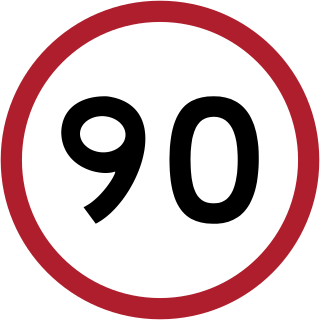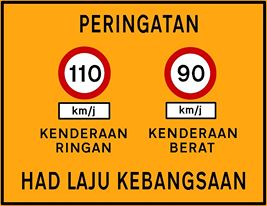
Speed limits on road traffic, as used in most countries, set the legal maximum speed at which vehicles may travel on a given stretch of road. Speed limits are generally indicated on a traffic sign reflecting the maximum permitted speed - expressed as kilometres per hour (km/h) and/or miles per hour (mph). Speed limits are commonly set by the legislative bodies of national or provincial governments and enforced by national or regional police and judicial authorities. Speed limits may also be variable, or in some places nonexistent, such as on most of the Autobahnen in Germany.

A limited-access road, known by various terms worldwide, including limited-access highway, dual-carriageway, expressway, and partial controlled access highway, is a highway or arterial road for high-speed traffic which has many or most characteristics of a controlled-access highway, including limited or no access to adjacent property, some degree of separation of opposing traffic flow, use of grade separated interchanges to some extent, prohibition of slow modes of transport, such as bicycles, (draught) horses, or self-propelled agricultural machines; and very few or no intersecting cross-streets or level crossings. The degree of isolation from local traffic allowed varies between countries and regions. The precise definition of these terms varies by jurisdiction.

Speed limits in the United States are set by each state or territory. States have also allowed counties and municipalities to enact typically lower limits. Highway speed limits can range from an urban low of 25 mph (40 km/h) to a rural high of 85 mph (137 km/h). Speed limits are typically posted in increments of five miles per hour (8 km/h). Some states have lower limits for trucks, some also have night and/or minimum speed limits.

Malaysian Federal Roads System, is the main national road network in Malaysia. All Federal Roads in Malaysia are under the purview of the Ministry of Works (MOW). According to the Ministerial Functions Act 1969, the MOW is responsible to plan, build and maintain all Federal Roads gazetted under the Federal Roads Act 1959. However, most of the Federal roads' projects were built and maintained by the Malaysian Public Works Department (JKR), which is also one of the implementing agencies under the MOW.

Road speed limits in Ireland apply on all public roads in the state. These are signposted and legislated for in kilometres per hour. Speed limits are demarcated by regulatory road signs. These consist of white circular signs with a red outline. Speed limits are marked in black with "km/h" below the speed limit. Smaller "repeater" speed limit signs are used along stretches of road where there is no change in speed limit, in order to remind motorists currently on the road and to inform traffic merging from junctions that a certain speed limit applies.
Speed limits in Australia range from 5 km/h (3.1 mph) shared zones to 130 km/h (81 mph). Speed limit signage is in km/h since metrication on 1 July 1974. All speed limits are multiples of 10 km/h – the last digit in all speed signs is zero. Speed limits are set by state and territory legislation albeit with co-ordination and discussion between governments.

A speed limit is the limit of speed allowed by law for road vehicles, usually the maximum speed allowed. Occasionally, there is a minimum speed limit. Advisory speed limits also exist, which are recommended but not mandatory speeds. Speed limits are commonly set by the legislative bodies of national or local governments.
Canadian speed limits are set by different levels of government, depending on the jurisdiction under which the road falls, resulting in differences from province to province. The limits have been posted in kilometres per hour (km/h) since September 1, 1977. Before then, when Canada used Imperial units, speed limits were in miles per hour (mph).

Road speed limits in the United Kingdom are used to define the maximum legal speed for vehicles using public roads in the UK. Speed limits are one of the measures available to attempt to control traffic speeds, reduce negative environmental effects of traffic, increase fuel use efficiency and satisfy local community wishes. The speed limit in each location is indicated on a nearby traffic sign or by the presence of street lighting. Signs show speed limits in miles per hour (mph) or the national speed limit (NSL) sign may be used.

Speed limits in Croatia are regulated by the Road Traffic Safety Act.

French roads have a variable maximum speed limit that depends on weather conditions. In dry weather rural 2- or 3-lane roads are limited to 80 km/h, 4-lane expressways 110 km/h, and highways 130 km/h. When raining, the limits are respectively lowered to 80, 100, and 110 km/h. Urban speed limit of 50 km/h is unaffected by weather. The general speed limit is lowered to 50 km/h on all roads in the fog or other low-visibility conditions if visibility is under 50 metres.

The default speed limits in the Netherlands are 50 km/h (31 mph) inside built-up areas, 80 km/h (50 mph) outside built-up areas, 100 km/h (62 mph) on expressways (autowegen), and, as of 16 March 2020, 100 km/h from 6:00 to 19:00 and 130 km/h from 19:00 to 6:00 on motorways (autosnelwegen).

Statutory speed limit in Japan defaults to 100 km/h (62 mph) for divided national expressways and 60 km/h (37 mph) for any other roads, unless otherwise posted. The highest speed limit in Japan is 120 km/h (75 mph) on some sections of Shin-Tōmei Expressway (E1A) and Tōhoku Expressway (E4). Urban two-way streets are usually zoned at 40 km/h (25 mph) or less.

General speed limits in New Zealand are set by the New Zealand government. The speed limit in each location is indicated on a nearby traffic sign or by the presence of street lighting. The limits have been posted in kilometres per hour (km/h) since 1974. Before then, when New Zealand used imperial units, maximum speeds were displayed in miles per hour (mph). Today, limits range from 10 km/h (6.2 mph) to 110 km/h (68 mph); in urban areas the default speed limit is 50 km/h (31 mph).

The Malaysian Expressway System is a network of national controlled-access expressways in Malaysia that forms the primary backbone network of Malaysian national highways. The network begins with the Tanjung Malim–Slim River tolled road which was opened to traffic on 16 March 1966, later North–South Expressway (NSE), and is being substantially developed. Malaysian expressways are built by private companies under the supervision of the government highway authority, Malaysian Highway Authority.

Four general speed limits apply on roads in Serbia:
The Automated Enforcement System (AES) is the road safety enforcement system to monitor all federal roads, highways and expressways in Malaysia. This system came into operation on 22 September 2012.

Speed limits in the United States vary depending on jurisdiction. Rural freeway speed limits of 70 to 80 mph are common in the Western United States, while such highways are typically posted at 65 or 70 mph in the Eastern United States. States may also set separate speed limits for trucks and night travel along with minimum speed limits. The highest speed limit in the country is 85 mph (137 km/h), which is posted on a single stretch of tollway in exurban areas outside Austin, Texas. The lowest maximum speed limit in the country is 30 miles per hour (48 km/h) in American Samoa.

Speed limits in Thailand are a set of maximum speeds applicable on any road in Thailand. For small cars that weigh less than 1,200 kg (2,646 lb), the maximum limits within the built-up area and outside are 80 km/h (50 mph) and 90 km/h (56 mph) respectively. The exception applies to motorways, in which small cars can use up to 120 km/h (75 mph). Heavier cars, buses and trailer have more restrictive limits. Despite having the general maximum speed limits, the limits may be altered by a roadside sign.


















